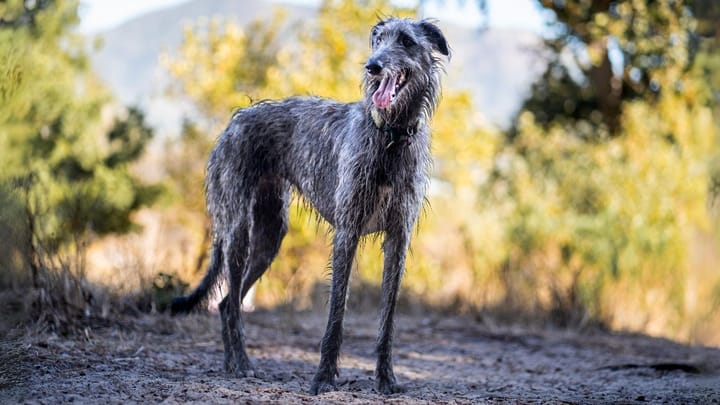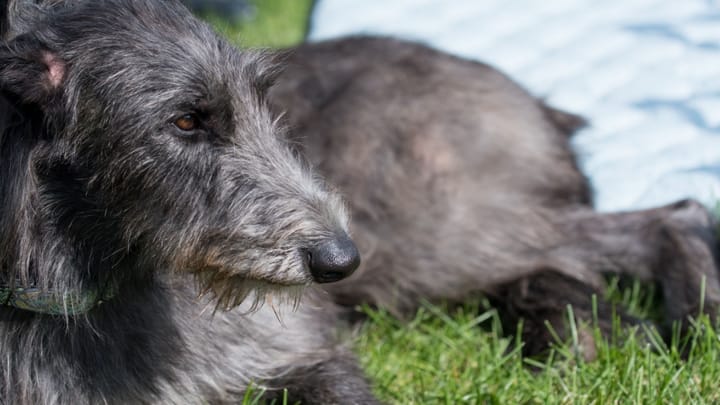Deerhound
Other name: Scottish Deerhound


The Scottish Deerhound is a calm, chilled-out, loyal and friendly dog. This large dog is the ultimate gentle giant - in fact, we’d go as far to say that it’s one of the friendliest breeds around! A dog of this breed gets along with anyone and everyone they meet - except cats and small animals, who they’ll chase for hours.
Those who have a large space for their pets to roam around, live an active lifestyle and seek an undemanding, affectionate companion won’t go wrong in picking a Scottish Deerhound as their next pet.
|
Life expectancy |
The Deerhound has a life expectancy of between 8 and 10 years |
|
Temperament |
|
|
Size |
Large
|
|
Adult size |
Female
Between 28 and 30 in
Male
Between 30 and 31 in
|
|
Adult weight |
Female
Between 79 and 82 lb
Male
Between 99 and 101 lb
|
|
Coat colour
The Scottish Deerhound most commonly has a dark grey or blue-grey coat, though they’re also seen in true brindle. Historically, they were also seen in yellow, red, and fawn. |
Blue Red Sand |
|
Type of coat
This breed has a medium length, wiry coat. The Scottish Deerhound originates from the Scottish Highlands - their thick, harsh and rough-textured coat helped keep them warm and dry in bitterly cold, wet weather. The hair on the belly, chest and head is soft in comparison to the rest of the coat. The Deerhound also has a little bit of a fringe on the backs of the legs and lovely, thick eyebrows. |
Long Hard |
|
Eye colour
The Scottish Deerhound has very dark brown or black eyes. |
Brown
|
|
Purchase price |
The Deerhound costs between £400 and £800 |
During the Age of Chivalry, nobody of lower status than an earl was allowed to own a Scottish Deerhound - yep, these pups were highly valued!
More details about the Deerhound
Deerhound: Origins and history
The Scottish Deerhound is native to the country which shares its name - Scotland, of course! This famous breed has been around since the 16th century but has formally been known by multiple names, including the Scotch Greyhound, the Rough Greyhound and the Highland Deerhound. For as long as the breed has been known, it’s been highly sought-after for its impressive ability to hunt deer.
Physical characteristics of the Deerhound
There’s no two ways about it - the Scottish Deerhound is a big dog! It’s sometimes described as a small horse due to is long, thin legs and lengthy neck. Despite their size, their height and lean, athletic appearance make for a very elegant pooch.
The head is widest from ear to ear and thins out towards the muzzle and nose, which is black. The ears are set high and turned back, while the eyes are full and dark. This breed also boasts a charming moustache and beard which definitely adds to their character.
FCI classification of the Deerhound
-
Group 10 - Sighthounds
-
Section 2 : Rough-haired Sighthounds
Deerhound: Characteristics
Deerhound: Behaviour
Training a Deerhound
The Scottish Deerhound falls right in the middle in terms of training - it’s not impossible, but it’s certainly not easy! They have a stubborn streak and short attention span which can make training tricky.
Plenty of praise and tasty treats are the best motivation for the Deerhound - without it, you’ll be fighting a losing battle. Do bear in mind that this breed is very sensitive and will take harsh correction or criticism to heart.
Deerhound: Lifestyle
Breed compatibility Deerhound
Deerhound: Purchase price
The Scottish Deerhound is hard to come across in the UK these days. If you manage to find one, they’ll cost between £400 and £800.
To care for a Deerhound, you would spend on average £140 to £210 per month.
Deerhound: Shedding
Average
The Scottish Deerhound sheds moderately all year round. Regular brushing will minimize this significantly.
Deerhound: Grooming
The Deerhound’s thick, wiry coat will need brushing once or twice a week and a bath only when they’re particularly dirty or smelly. It’s also useful to comb through their entire coat once a week to avoid tangles. Their nails grow fast and will need clipping regularly.
Check their ears and eyes for signs of infection and clean gently if necessary. Brush their teeth as often as possible - ideally daily but at least once a week.
Deerhound: Health
On average, the Scottish Deerhounds lives between 8 and 10 years.
The Scottish Deerhound is a strong, agile and athletic breed which is built for speed and endurance. Despite their friendly nature, they’re real tough cookies.
Due to their thick skin and coat, the Scottish Deerhound will get hot quickly and should be taken inside to a cool room and given ice water in hot temperatures. They won’t cope in hot environments.
On the contrary, this breed is truly suited and booted for the cold. They were originally bred to work in the harsh, cold climate of the Scottish Highlands, so their thick, wiry coat can take on all the elements.
Although the Scottish Deerhound is a relatively athletic dog, the breed is known to be prone to weight gain. Make sure your dog gets adequate exercise and measure out food every day - it’s easier than you think to overfeed them!
- Cardiomyopathy
- Bloat
- Allergies
- Dental disease
- Heart disease
- Hypothyroidism
- Neck pain
- Atrophy
- Liver Shunt








